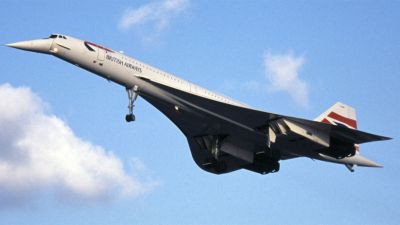
Concorde: The History, The Speed & The Crash
Discover the monumental saga of the Concorde, an iconic supersonic masterpiece that enthralled travelers with unparalleled velocities,…

Braniff International Airways was an innovative, forward-thinking, iconic American airline that started many trends in the airline industry, several of which are still being utilized today.
Operating from 1930 through 1982, Braniff flew routes throughout the middle and southwestern portions of the United States, as well as Panama, South America, Europe and Asia. The “perfect storm” of increased competition, overexpansion and extremely high fuel prices forced the company to shut down on May 12, 1982.
Braniff International is creating the most beautiful airline in the world. We hired Emilio Pucci to design our uniforms. Our hostesses wear reversible coats of almond green and apricot, space helmets to keep out the rain, red spacesuits and sometimes something a little more comfortable... We have blue planes, orange planes, yellow planes… You can fly with us seven times and never fly the same color twice... Braniff international announces The End of the Plain Plane. We won't get you where you're going any faster, but it'll seem that way. - 1960s Braniff TV Commercial
The original Braniff airline operation was known as Tulsa–Oklahoma City Airways. It was started by Thomas E. Braniff, an insurance salesman and financial executive. Teaming up with his brother, Paul Revere Braniff, they offered passenger service throughout Oklahoma. Ultimately, ownership in the company was given up and it was purchased by aviation Corporation (AVCO) holding company. AVCO also owned other airline assets including what was to become eventually American Airlines.
Free of the burden of their original venture, Thomas and Paul Braniff started up a new airline called Braniff Airways, Incorporated. They slowly expanded through the Midwest. In a bid to get the Chicago – Dallas airmail route, Paul Braniff presented the airline's case in Washington DC. With the blowback from the famous 1934 Airmail Scandal fresh on their minds, the United States Post Office gave them the Chicago – Dallas route in 1935. Paul Braniff left the company later that year while Tom Braniff stayed to run the company. He hired Charles "Chuck" Beard to take over the daily tasks of running a growing airline. Beard eventually was named President And Chief Executive Officer of the company in 1954.
 ?
?
Braniff absorbed several smaller airlines as it grew. In addition, they purchased new aircraft including Douglas DC–2s and Douglas DC–3s. They concentrated their routes in the Midwest. During the Second World War they leased airplanes to the military and offered their facilities in Dallas to help train pilots. In the 40s, the company began to serve routes in the Caribbean as well as Central and South America, often flying Douglas DC-6s on these flights.
The company began to expand nationwide in the 1950s. They purchased Midcontinent Airlines which added several cities to their primarily North-South system. Along with their added routes, in 1957 the company christened a new building close to Dallas Love Field. It served as their headquarters until they moved to Braniff Place in 1978.
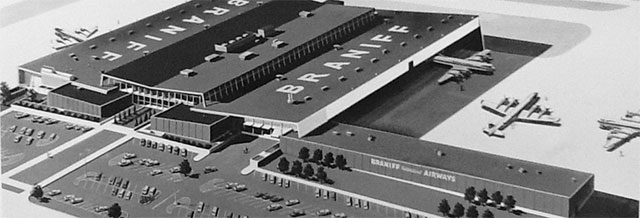
Braniff at Love Field
In 1954, Thomas Braniff was killed when the “flying boat” he was in crashed near Wallace Lake in Louisiana. His hunting party was leaving the lake when the wings iced over and the pilot attempted to bring the plane back down. Unfortunately, one of the wings hit tree stumps which caused the plane to crash and catch fire. All 12 passengers were lost.
1954 was not a great year for Braniff. Paul Braniff died that year from cancer. After Tom's death, Chuck Beard became the president, the first non-Braniff family member to hold that position. He was instrumental in steering the company into the modern age: By 1965 he transitioned almost the entire fleet to jets.
Braniff was acquired by the Great America Corporation in 1965. C. Edward Acker, Chief Financial Officer of Great America claimed that Braniff was a poorly managed company, and he stepped into the role of Executive Vice President and Chief Financial Officer.
Also in 1965, the airline hired Harding L. Lawrence, at the time an Executive VP of Continental Airlines. He became the new President of Braniff international. He felt that the airline was somewhat backwards and wanted to give them a new, modern image. Over the next decade and half he expanded the company into new markets and tried unorthodox ideas. The result was significant financial gains: The airline multiplied its earnings 10 times in that time period.
As part of the modernization effort, the company enlisted the help of Jack Tinker Associates, who put fast rising advertising whiz kid Mary Wells on the case. She is better known as Mary Wells Lawrence, having married Lawrence in 1967 in Paris.
Their first goal was to change Braniff’s image. The Airlines livery consisted of traditional red, white and blue colorings which the advertising firm thought was boring. They called on the talents of fashion designer Emilio Pucci, shoe designer Beth Levine and architect Alexander Girard to make a wholesale change in the companies branding. This was called the "End of the Plain Plane."
One of the more dramatic changes was based on Girard's suggestion that they use a single bright color on each aircraft. His goal was to cover each plane in exotic colors like "metallic purple." The company modified this design with white wings and tails, which recalled a paint profile from the 1930s called the Braniff Vegas scheme. Nicknamed the "jellybean" fleet, the new colors included turquoise, lemon yellow and lavender. Interestingly, lavender was discontinued as it is a bad luck color in Mexico.

The interiors received as dramatic a change as the exteriors. Girard covered the seats with Herman Miller fabrics. He also created a new line of furniture for the ticket areas and lounges. Braniff offered the same furniture for sale to the public in 1967 for that year only. The exotic color schemes were carried from the airplane exteriors to the gate areas, ticket offices and the company headquarters as well. The walls featured complementary art from around the world.
Not to be outdone, Pucci made major changes in the crew uniforms. Beth Levine came up with two tone boots and shoes. The moniker "stewardess" was changed in favor of the word "hostess."
The creativity of the new designs infiltrated the next batch of advertising as well. Mary Wells brought in celebrities like Sonny Liston, Salvador Dali and Andy Warhol in a stylish, some say "arrogant" campaign that was unlike any other marketing effort of the era. One tagline read, "if you've got it – flaunt it!"
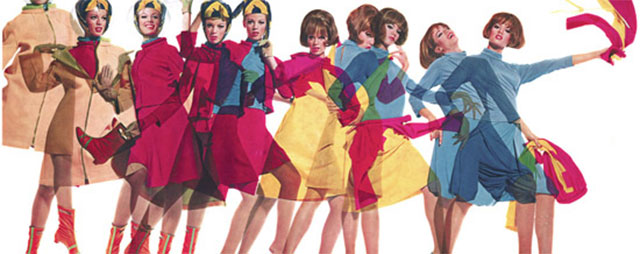
Hostesses began a tradition of removing outerwear on board, calling it the "Air Strip," which was featured in one of their commercials (https://www.youtube.com/watch?v=MKiVCkE0dDw). The airline loved the new campaigns, but many corporate accounts were outraged and ended their relationship with Braniff.
In 1959 Braniff used Boeing 707-227's as well as the 707-200. In 1971, they sold off the 707-227s and 720s were purchased. In 1964, they acquired a BAC One-Eleven twin jet. By the middle of the decade, they had a fleet comprised of almost all jets. When Lawrence took over the company, he stopped buying BACs, instead selecting bigger Boeing 727s.

After that, they ordered several Boeing 727s including the elongated B727-200, and the 727-200 Advanced. Near the end of the 1960s, the company had ceased operation of all their Lockheed L-188 Elektra turboprops, which made them an "all jet" airline. In the 1970s, they concentrated on the Boeing 727. The inventory consisted of 70 B727s, a single B747 and a clutch of 11 DC-8s.
Braniff offered Concorde service in 1979, flying out of the United States from Dallas to Washington DC, and then on to London and Paris, with interchange flights offered by partners British Airways and Air France. American crews handled all the flights from Dallas to Washington, DC, and British and French staff handled the Washington to Europe leg. Over the United States, the government limited the Concorde to Mach 0.95. Once they had open water however, they cranked it up to Mach 2.

The Braniff Branded Concorde.
Ultimately, the Concorde was a financial noose around the neck of the airline. Although Braniff offered extremely reasonable rates, they were usually only able to fill 15 of the 100 seats on the Concorde. At the same time, they flew Boeing 727s over similar routes that were filled to capacity. As a result, the Concorde experiment only lasted about a year. Many postcards from the era depict a Concorde with Braniff livery. However, this never took place in reality, as the Concorde only featured liveries from Air France and British Airways during its lifetime.
In the mid-60s, Braniff took over the operations of Pan-American Grace Airways (PANAGRA), which strengthened their operations in South America. The company was also active in taking Vietnam military to Hawaii for their furloughs during the war. The company's commitment to cutting-edge thinking continued when they opened their "Terminal of the Future."
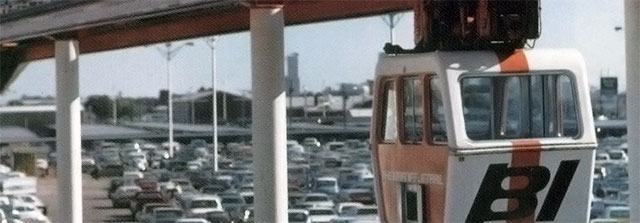
The Braniff Jetrail System
Other modern concepts the company was involved in included Jet Rail, a fully automated monorail system. Braniff executives also made significant contributions to the planning and design of the new Dallas-Fort Worth international Airport, providing many creative new ideas never seen before in the airline industry.
Another example of their cutting-edge thinking was in 1973 when the airline asked Alexander Calder to create a specially commissioned paint scheme. His "Flying Colors" Douglas DC-8 was immediately controversial. Showcased at Paris Air Show, it featured very bright colors common to Latin countries. As such, it was primarily used in South America. Two years later, he created "Flying Colors of the United States," a Boeing 727-200 which was commissioned to help celebrate the United States Bicentennial. A year later, Calder died as he was finishing another livery called "Flying Colors of Mexico," which was ultimately not used on any aircraft.
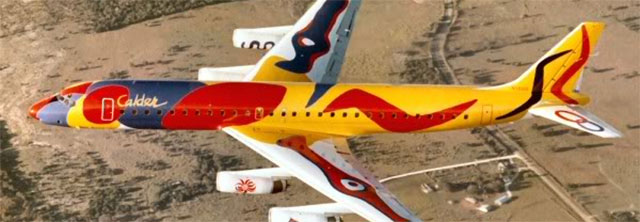
Calder's "Flying Colors" DC-8
In the late 1970s, the company ended their relationship with Pucci as the uniform designer. Instead, they enlisted the help of fashion icon Halston, who returned the company's designs to a more American-influenced style. Known for his all-leather designs, they were used for uniforms and airplane interiors alike, including new Boeing 727 – 200s. His simple fashions were a hit with both the flying public and industry pundits.
The company had the honor of taking delivery of the 100th Boeing 747 ever made. It was a 747 -127, which kicked off the "jumbo jet" era. Marketing campaigns called the aircraft "747 Braniff Place" or "The Most Exclusive Address In The Sky." It was used in the first flight out of Dallas to London. Other 747s, like the 747 SP were used to fly to Europe and Asia. The old Douglas DC-8s were beginning to show their age. The company debated whether to buy McDonnell Douglas MD-80s to replace them, or opt for Boeing 757s or 767s. Financial difficulties later made the debate mute.

Through the 1970s, Braniff was one of the most successful airlines. It was hit hard by the regulation of the American airline business in the late 70s. Company leadership chose to expand in response to the regulation. They added several new cities and routes-- it was believed to be the biggest single day expansion by any airline ever. They created international hubs in both Los Angeles and Boston to take on increased loads on the international front. They had plans to establish routes to Tokyo as well as an "energy run" in between the oil capitals of Dallas, Houston and Dubai. Ultimately, these international routes never came to fruition.
Things went downhill from there. Despite many new routes and destinations, Braniff was unable to develop much new business. The 747 flights out of international hubs were not going according to plan, often flying almost empty. The cost of acquiring the goods and equipment needed to support all of the new hubs added significant debt to company balance sheets. In addition, the move of flight operations to the Dallas-Fort Worth airport added even more debt. Then they moved their headquarters to the brand-new Braniff Place. The combination of rapid expansion, seriously increased debt and a debilitating recession resulted in Harding Lawrence being removed from his position in late 1980.
In 1982, Howard Putnam made an unsuccessful attempt to get relief from creditors and gain an extension on outstanding debts that had grown tremendously while Harding Lawrence was in power. After failing to get an extension, the company stopped all business, which marked the end of 54 years of continual operation. Flights out of Dallas never left the ground, and passengers already sitting on jets ready to depart were asked to leave the aircraft. In a last show of independence and defiance, Braniff Flight 501 departed without authorization to Honolulu, and did not listen to further orders to land in Los Angeles.
Several airlines were born from the ruins of Braniff Airlines. Some employees created Sun Country Airlines which featured a collection of Boeing 727-200s and DC-10s. The airline lasted from 1983 through 2001, at which point it had to reorganize and now offers flights on Boeing 737-800s.

The Hyatt Corporation founded Braniff Incorporated in 1983 but its finances ran out at the beginning of the 1990s and it ended operations. Financial executive Jeffrey Chodorow started Braniff International Airlines, Incorporated in 1991 using the assets of the failed Braniff Incorporated (which was under the corporate name of "Dalfort.") That initiative ended in 1992 due to malfeasance.
Two other attempts were made to start an airline operation using the Braniff name in some capacity. One concern had the goal of using Boeing 757s and another outfit wanted to offer discount tickets to an exclusive "Braniff club." Neither of these ideas gained any steam.
Any assets of the original Braniff are handled by a firm called "Asworth," created out of what was left of the original "Dalfort" Corporation. At exists mainly to make sure pilot pensions are paid.
Braniff Airlines continues to capture the imagination of aviation, marketing, design and innovation enthusiasts around the world. Appreciation sites like Braniff International Historical Site celebrate the independent spirit of the airline.

There are also several videos on YouTube detailing the history of the company in images and music (https://www.youtube.com/user/BraniffPages).
The book "Splash of Colors-the Self-Destruction of Braniff International" has a 4.8 out of 5 stars rating at Amazon.com. It sells “new” for almost $100, a reflection of the continuing interest and appreciation for Braniff's contribution to the aviation industry. The book details the drama and intrigue behind the scenes as the company over expanded and then tried to correct itself after deregulation.
Braniff captures people's imagination much like the Concorde does. Both represent a time in the airline industry when everything seemed possible. Braniff evolved along with America itself, moving from the homogenization of the 1950s to a new world of experimentation and innovation in the 1960s.
Looking back, many of the designs and ideas seem too "far out," even in today's world. It doesn't matter. The joy and energy of the liveries, interiors, and crew uniforms was a perfect match for the increasing profitability and efficiency of the airline operation. For many, Braniff represents the fun of air travel in a much simpler time.

There have been many creations of Braniff aircraft for FSX, FS2004 and even as early as FS98. Some of the best include this Braniff 727-200 for FSX and a great 747-SP for FS2004 (it may also work in FSX). If you prefer earlier prop aircraft, the 1950s Lockheed L-049 is a stunning model.
Let's hear your comments below discussing this airline, sharing your memories and flights you may have had with Braniff.
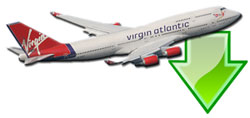 Don't forget... We have a huge selection (over 24,000 files) of free mods and add-ons for MSFS, FSX, P3D & X-Plane in the file library. Files include aircraft, scenery, and utilities All are free-to-download and use - you don't even need to register. Browse on down to the file library here.
Don't forget... We have a huge selection (over 24,000 files) of free mods and add-ons for MSFS, FSX, P3D & X-Plane in the file library. Files include aircraft, scenery, and utilities All are free-to-download and use - you don't even need to register. Browse on down to the file library here.
21 comments
Leave a ResponseThe content of the comments below are entirely the opinions of the individual posting the comment and do not always reflect the views of Fly Away Simulation. We moderate all comments manually before they are approved.
I have four not so perfect black and white posters of owners and crew. Would they be good for you to use?
Richard - Yes, these would be brilliant to use in the article. If you wouldn't mind sending them to me via email (you can get it by using the "Contact Us" link at the bottom of this page) then that would be great!
I'll add the poster to the article and also mention that you are the source.
As a young U.S. Air Force Airman stationed in San Antonio, Texas I flew home to Dallas, Texas quite a bit. I would adjust my schedule each trip to fit in a flight on Braniff. I would not fly any other airline on that route. The jets were all painted in really neat paint schemes, the stewardesses (or stewardi, I never knew which was correct) were all foxes and they just loved to see me in my white ascot, bloused boots and white rope. I always "dressed up" when I flew home. I hated to see the airline finally go the way of the dinosaur. Love Field was always on point back then, also. I guess I kinda miss it.
Bill T. USAF, Retired
I was and will always be, a Braniff fan. The first time I ever flew, I was in my early twenties and was coming from Panama to Dallas, Texas ( to get married), Flyingon a Braniff's Panama/Dallas route. Dallas became our home and we flew this route rseveral more times as a couple and as a young family of three. Every time we traveled on Braniff, it was an event: the colors, the seats, the service, the food; the stewardesses were so beautiful and attentive--we felt like VIPs, and were so proud that this airline was based in Dallas! When Braniff closed, it was as if we had lost a close relative. So many dear friends lost their jobs and felt lost in the job market. Braniff was a big loss for Dallas. I still miss Braniff.
I was 18 years old an on my way to basic training at the Navel base & Training Center in San Diego Ca. when I took my first flight on a Braniff Airline, an for a young Texas Country boy it was an experience that has stayed with me for 67 years. The flight attendents were some of the most beautiful women that a young 18 year old boy had ever seen, they were kind, helpful, very pleasant, engaging and they were just plain down home Beautiful like the girl next door. It is too bad that the Price of fuel cost the American People a great Airline, I wish they were still in business.
as an employee of Braniff for 24 yrs I loved the company and my fellow employees. we were one big family and sincerly tried to be the best airline with the best service
I flew Braniff Charter flight, Travis AFB, Honolulu, Wake Island on to Okinawa; May 1968.
Fabulous crew, and yes, they were also very attractive and entertaining !!!
Wow, I worked as an in -flight hostess for Braniff based out of Dallas Texas in the late 60's. Completed my training at the Braniff training school and flew Mexico City turn arounds daily. As a fluent spanish speaker I was, as a new hire, able to hold a senior route. The training was intense. The colorful planes and bright interiors as well as being know as the 'On Time' Airline not to mention our Emilio Puce uniforms made our airlines stand out beyond the rest. I can honestly say I am still proud to say I flew for the best airline at that time. What a wonderful experience for both employee and passenger. Sincerely....
Flew my son, Jeff, from Connecticut to Mississippi on Braniff. What a great flight!! The flight hostesses were enamored of Jeff, who had Down syndrome, and gave him a set of Braniff insulated cups in black and white. Made him so happy!!! The cups are now for sale to a Braniff collector. Jeff passed in 2006 at age 51. PM me or email to bjdarscs@bellsouth.net. Thanks.
I have always loved Braniff International as a loyal Braniff fan since the late 1960s. I used their red 727-l00s,707-320Cs in orange in some Business Week magazines. I got to see a beautiful lime green 707-320 series at JFK in December 1969. It was parked near the British Airways terminal on the east side of that airport. I saw a red and a light beige 707 at HNL in 1969. I think that Chicago ,DFW and Austin route was using primarily two toned painted 727s in 1977. Both flights in both directions were green two tone painted 727-200s. My great aunt and I made a game of what color plane would I go on back to Chicago. We both lost! In other words it was really hard to predict what color it was ;being used for every flight. I can think of just 4 colors in 1977. Blue,green,orange and red. I don't recall seeing other colors used then. I do miss Braniff a lot. I wish that Braniff would return to us soon;in the Alexander Girard color scheme;the jelly bean fleet.
I worked for Braniff International for 15 good years of my life. I first worked in Commisary at Love Field and actually flew back and fourth to DFW airport to work. Soon after the move I became a Customer Service Agent and worked in Operations as well as Gate Agent ant Braniff Ticket Counter at several Braniff cities throughout the US. My Airline Employment was an enlightening and wonderful experience. I travel many routes outside the US with my wife and was never treated better on any airline carrier. I feel blessed and enlightened for the great times I spent with the "Braniff Family". My wife and I continually speak with many friends we acquired through Braniff. I have NEVER heard an unkind word from anyone who was employed that exceptional airline.
My mother's elder brother was Joe Williams, who spent the greatest part of his life working for Braniff, starting in the late 1930's. He lived in Dallas, first on the south side of Love field, later in North Dallas. That house was about one block off the final approach for the north-south runway. I remember the sound of the propliners and would always watch for the Braniff ones. Mom would send me to Dallas to have a summer with my many cousins on a Continental inter airline pass from ABQ. Joe was in Operations so his concerns were with weather, fuel, and staffing. Occasionally he would pile all us kids in the car and take us to the Lemmon Avenue O & M base where he worked. I didn't realize until years later that it was designed by famous Los Angeles architects and was a super example of MidMod design. He would tour us through the hangars or the shops or the flight simulators (pre-computer, used moving belts for the terrain). I also remember him taking us to the Braniff offices at Exchange Park to pick up his paychecks. Joe was responsible for manuals for the introduction of the Boeing 727 at Braniff and had a lot to do with Braniff's pioneering efforts in computer flight reservations (residing in a Lemon Ave. motel to be away from a distracting family). The Flying Colors were temendously exciting and I loved them. It was great to bicycle out to Stapleton and see them on the B Concourse. Joe would complain about the white tails when the planes were not washed enough -- "dirty boots". Yes, I had a very strong connection to Braniff.
Worked for Braniff for 24 years starting in Chicago, then to Minneapolis for 13 years and on to Las Vegas until they went under. I stayed on in Las Vegas worked at the Rio Hotel for 17 years until January 2005, then moved back to Wisconsin.
I grew up with Braniff in the family ( father Braniff pilot Robert (Bob) Howard, step mother, flight attendant Kay Howard and former Pan Am flight attendant) from the early 1960's through it's final chapter in the early 1980's. What a fantastic airline it was!
I started to work for Braniff àt Bogota , Colombia in March 1962, as a Cargo agent, and later as passengers service, operations, asistant manager, until February 1967 when I was transfered to Cali , Colombia as Airport director , due to the acquisition of Panagra, routes, . I was the first and last Braniff airport director at Cali, .In 1982 Eastern Airlines took over. Working for Braniff , was a "way of life" , Braniff international remains in the heart of all the employees , who had fortune to work for this, the Very Best airline that existed in the whole world. , 20 unforgetable and happy years of my life were at Braniff
I acquired an old Braniff luggage tag that had a destination of Reno, NV (RNO). Peach colored with the number 18-95-42. Any idea how old it is?
BI employee from Mar. 74 (HOU Res) to May 82 (SEA) with stops in PHX, PBI, ATL, RNO, and BNA. Best 8 years of my life. Miss it, all of "y'all" every day.
I was honored to be part of the Calder Colorguard, fortunate enough to be able (to purchase full fare as pass-riding was a big "NO") on the first Concorde flight DFW-IAD. Didn't particularly for Mgt. they are in HOU res, but fellow employees, and yes, even the grind of answering call after call, was a treasure.
THANK YOU ALL!
To P. Northrop on your asking about an RNO bag tag.
Braniff started operations in RNO in late summer/fall of 1978. I was working in Nashville and jumped at the chance to go to Reno. The station was opened with temporary transferees (I don't remember the exact timing of that) and then was put up for bid (for transfer to) in, like I said, late summer/fall.
I remember driving Nashville to Reno, nonstop, on Labor Day weekend of 1978 to get there as soon as possible.
The bag tag, therefore, is no older than mid-1978.
Hope this helps. Tom Armstrong (former BI #38568)
I was working at the British Aircraft Corporation at Hurn in the UK in 1964 and recall the BAC One Eleven. I recall the day it was delivered. It took off from the airfield with an Indian head painted on the tail.
What a beautiful sight. I believe it was on its way to Texas if I recall correctly. Too bad it was the only one they purchased.
This site may no longer be active but I enjoyed reading it. As the Director of Kansas City, Missouri's Department of Aviation between 1974 and 1990, I vividly recall the first bankruptcy closing. I was returning to Kansas City from a meeting in Montreal and changed planes at Cincinnati's airport where there was a delay in the take-off of the USAir Flight to Kansas City.
After we were in the air the pilot informed us that the delay was because Braniff had just ceased operations and US Air was using a Braniff gate and service employees at Kansas City International. My wife was meeting me at the airport and we drove from another terminal to the Braniff terminal where I found the Braniff Station Manager and a few other employees who were as stunned as I was.
I worked for Braniff in N.Y. 1956-1959. I recently wrote a memoir about Texas. Is there anyone interested who would like a copy?